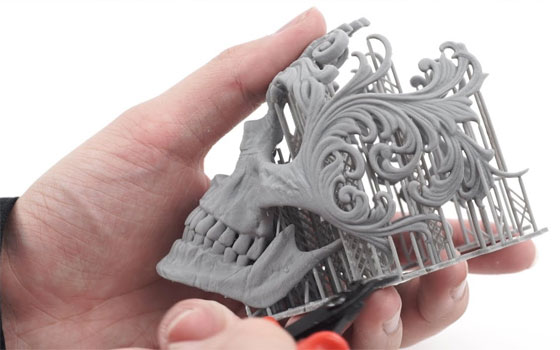Removing Support Structure from 3D Prints
Tweet
Some 3D printing procedures will require what is known as support. Since we can't print immediately and inexplicably and the laws of material science and gravity likewise represent 3D printing, a few articles with overhanging parts need support structure. In this blog entry you will find which materials use support structure, what this implies for you as a client, and how you can expel support structure from resin prints yourself.
Tips for erasing 3D-printed supports
As a matter of first importance, a general update: work gradually and circumspectly when evacuating support structure. Dainty and nitty gritty Standard Resin parts are substantially more weak than thick and strong ABS parts. In this way, alert and accuracy are critical.
Before you chip away at your primary print, make a point to begin with a test piece or with the least visual piece of your model. Support structure that was included is created with top of the line programming that naturally plans and appends those lightweight structures to your print.
The support is normally associated with the print with slim association parts. It is encouraged to remove the support extremely near the real print. This will make sanding the part a lot simpler.
Instructions to expel support structure from 3D prints
There are huge amounts of cutting edges and instruments to look over. Which instrument works best for you relies upon numerous factors, for example, the shape and size of the print, the material, and your own inclinations. It frequently bodes well to utilize a mix of these sharp edges. These are the most widely recognized and most mainstream instruments that our locale employs.
Numerous individuals utilize a needle nose plier. These are normally utilized for support that can be split away, as opposed to removed. So while this is an incredible apparatus to work moderately quick, it is less appropriate for parts that need exact control. A flush shaper may be a decent option since it consolidates quality and exactness.
Clay type blades, scrubber blades, or bed blades with honed edges are now and then utilized for evacuating support also. They are regularly utilized for enormous scope models without little subtleties. So it may just bode well to expel the unpleasant and external parts of the support with these sorts of blades.
Xacto blades are a famous decision and give you heaps of exactness. With these, you can neatly remove the little components that associate support structure and articles in Standard Resin. The main drawback is that they are extremely sharp and a solitary slip can bring about a cut finger or a scratch in your 3D print.
A few people like warming the cutting edge or even the model so as to make it simpler to cut off the support structure since it will be a lot milder. Ordinarily, a minuscule butane burn is utilized for this. On the off chance that you need to go for this alternative, make a point to be cautious, for both yourself and your model.
Sanding off the outside of the 3D print
When the cutting is done, you presumably need to dispose of the little outstanding support components and imprints. This is the reason the following stage is tied in with cleaning your model. For this, sanding with high coarseness sandpaper somewhere in the range of 220 and 12000 can do some amazing things.
While utilizing sandpaper will make your part smoother and wipe out the final support parts, it will change the shade of the print. Essentially, it will be conceivable to see which parts of the print have been sanded. This is the reason it bodes well to shading the print a while later.
A few clients even go for a little drill-like device, for example, a Dremel. These handheld processors, with an assortment of bits and connections, can smoothen parts. For Standard Resin, we would recommend against utilizing them, in any case. They are just excessively quick and amazing. They produce heat that can disfigure the part and offer too little control for sensitive subtleties.

Gallery
Feel free to contact us for BIM requirements. One of our representative will respond you within 24 Hours. Send us your projects requirement today and grow your project.
Explore More !







